Open Journal of Social Sciences, 2019, 7, 176-188
https://www.scirp.org/journal/jss
ISSN Online: 2327-5960
ISSN Print: 2327-5952
Research on the Development of “Ghost City”
Based on Night Light Data: Taking Sichuan
Province as an Example
Qiqi Zeng1, Wenjun Zhang2
1School of Civil Engineering and Architecture, Southwest University of Science and Technology, Mianyang, China
2School of Environment and Resources, Southwest University of Science and Technology, Mianyang, China
How to cite this paper: Zeng, Q.Q. and
Zhang, W.J. (2019) Research on the Devel-
opment of “Ghost City” Based on Night
Light Data: Taking Sichuan Province as an
Example. Open Journal of Social Sciences,
7, 176-188.
https://doi.org/10.4236/jss.2019.712013
Received: November 17, 2019
Accepted: December 6, 2019
Published: December 9, 2019
Copyright © 2019 by author(s) and
Scientific Research Publishing Inc.
This work is licensed under the Creative
Commons Attribution International
License (CC BY 4.0).
http://creativecommons.org/licenses/by/4.0/
Open Access
Abstract
Due to the improvement of urbanization level and unreasonable development
in China, many cities have begun to appear as “Ghost City”; that is, the phe-
nomenon of high vacancy rate and low occupancy rate in urban areas. The
emergence of this phenomenon will seriously affect the healthy development
of cities. Therefore, the monitoring and analysis of the urban “Ghost City” index
is of great significance to urban population and urban construction. This paper
uses Landsat8 remote sensing image data, night light remote sensing image
data, and resident population data of various cities and counties in Sichuan
Province to calculate the “Ghost City” index, and obtains the “Ghost City”
Index of prefecture-level cities and county-level cities in Sichuan Province.
Based on the judgment criteria of the Ghost City, the calculation results show
that three cities have become “Ghost City” within the research scope; eight ci-
ties have a tendency to develop into “Ghost City”; the rest of the cities have
developed well and there has not been a “Ghost City” phenomenon. Accord-
ing to this conclusion, this paper studies the similarities and differences be-
tween the cities that are the ghost towns or the cities with the development
trend of ghost towns, analyzes the reasons for the formation of ghost towns
and makes suggestions for the urbanization of Sichuan Province, and pro-
vides reference for the direction of urban development and rational planning.
Keywords
Urbanization, DMSP/OLS, “Ghost City” Index, Light Gray Value
1. Introduction
Since the reform and opening-up, China’s urbanization has increased, and the
176
Open Journal of Social Sciences
DOI: 10.4236/jss.2019.712013 Dec. 9, 2019
�
Q. Q. Zeng, W. J. Zhang
urbanization process has gradually accelerated, and the demand for housing has
also risen sharply. The National Urban Land Use Data Summary Results Analy-
sis Report [1] mentioned that the national urban land area increased by 1.65
million hectares in 2009-2014, with an average annual growth rate of 4.2%, indi-
cating that urban construction land is increasing in a large amount. The devel-
opment and unreasonable development of the city led to the emergence of emp-
ty cities or ghost cities, that is, the phenomenon of high housing vacancy rate
and low occupancy rate [2].
Due to the insufficient monitoring of the dynamic changes of urban popula-
tion information, the phenomenon of “Ghost City” has appeared one after anoth-
er. The emergence of this phenomenon has seriously affected the development of
the city and restricted the advancement of urbanization, resulting in the waste of
land resources and weakening urban operational efficiency. The criterion for
“Ghost City” is that the ratio of urban population to built-up area is less than 0.5
or slightly higher than 0.5 (the standard is based on the land occupation stan-
dard from the Ministry of Housing and Urban-Rural Development, the built-up
area per square kilometer holds 10,000 people), this criterion known as the
“Ghost City” Index. This study takes Sichuan Province as an example, combined
with the 2013 Landsat8 OLI_TIRS and DMSP/OLS night-time remote sensing
image data, through the fitting of the urban population and the extraction of the
built-up area, to achieve the city-level and county-level cities in Sichuan Prov-
ince. The analysis and monitoring of the “Ghost City” index, and through the
analysis of the reasons for the formation of the ghost city phenomenon, propose
corresponding countermeasures, and provide the basis for urban development
and planning.
2. Research Scope and Data
2.1. Research Scope
Sichuan Province has complex landforms and has four types of landforms: moun-
tains, hills, plains and plateaus. Therefore, this paper selects Sichuan Province as
the research scope and provides reference for the study of ghost cities in other
cities in China. Sichuan governs 18 prefecture-level cities, 3 autonomous prefec-
tures, 17 county-level cities, 108 counties, and 4 autonomous counties. In this
study, only 18 prefecture-level cities and 17 county-level cities were selected as
research areas analysis (Figure 1) and monitoring of the “Ghost City” index in
Sichuan Province.
2.2. Data Sources
1) Luminous remote sensing image data. The night-time remote sensing im-
age data used in this paper is from the National Geophysical Data Center
(https://www.ngdc.noaa.gov/eog/dmsp/downloadV4composites.html) and is de-
fined by the Defense Meteorological Satellite Program. The Operational Lines-
can System (hereinafter referred to as OLS) on the linear scanning service system
177
Open Journal of Social Sciences
DOI: 10.4236/jss.2019.712013
�
Q. Q. Zeng, W. J. Zhang
Figure 1. Research scope.
(DMSP) was taken in 2013. In this paper, the data of the night light in Sichuan
Province extracted by the study is 0 - 63, the saturated light gray value is 63, and
the spatial resolution is 1km (Note: Due to the DMSP/OLS luminous remote sens-
ing image data on the National Geophysical Data Center website as of 2013, the
research data selected in this paper is the 2013 data).
2) Landsat8 OLI_TIRS remote sensing image data. The satellite imagery cov-
ering the whole region of Sichuan Province was selected in 2013. The data comes
from the Geospatial Data Cloud Platform of the Computer Network Information
Center of the Chinese Academy of Sciences (http://www.gscloud.cn).
3) Population data of city-level and county-level cities at various levels. From
the China Statistics Information Network (http://www.tjcn.org/).
4) Other auxiliary data. It mainly includes vector administrative boundaries at
the national, provincial, municipal, and county levels in China.
3. Data Processing
3.1. DMSP/OLS Data Processing
In order to obtain the remote sensing image data of the study area, the obtained
DMSP/OLS luminous remote sensing image data is tailored according to the ad-
ministrative boundary vector data of Sichuan Province, and the DMSP data of
various cities and county-level cities in Sichuan Province are obtained (Figure 2).
3.2. Extraction of Urban Built-up Areas of Landsat8 OLI_TIRS Data
The Landsat data of the studied cities were analyzed, and the land use data in-
cluding the use of construction land, forest land and water bodies were obtained.
178
Open Journal of Social Sciences
DOI: 10.4236/jss.2019.712013
�
Q. Q. Zeng, W. J. Zhang
Figure 2. DMSP data of various cities and county-level cities in Sichuan Province.
The important basis for assessing the level of urban development is urban con-
struction land. Researchers at home and abroad have made a lot of research on
the extraction of urban construction land. Among them, Xu Hanqiu [3] pro-
posed to use the IBI building land index to extract urban built-up areas from re-
mote sensing images. Accuracy can reach more than 96%. The IBI building land
index can be constructed by the three indexes of normalized building index
NDBI, vegetation cover index NDVI and improved normalized water body in-
dex MNDWI.
Calculation formula as follows:
(
(
=
MNDWI
NDVI
NDBI
=
=
+
−
B6 B5 B6 B5
)
)
B3 B6 B3 B6
B5 B4 B5 B4
(
) (
) (
) (
−
+
−
(1)
(2)
)
(3)
+
Among them, B3, B4, B5 and B6 are the green band, the red band, the near-
infrared band, and the SWIR1 band of the Landsat8 OLI_TIRS image.
The IBI building land index formula is as follows:
)
)
NDBI NDVI MNDWI 2
NDBI NDVI MNDWI 2
IBI
+
+
−
+
(
(
=
(4)
Substituting the Equation (1), Equation (2), Equation (3) into the Equation
(4), the finishing can be obtained:
(
(
(
2 B6 B5 B6 B5
(
2 B6 B5 B6 B5
) (
) (
IBI
+
+
−
+
−
−
)
)
=
B5 B4 B5 B4
B5 B4 B5 B4
+
+
−
−
) (
) (
)
)
−
+
(
(
B3 B6 B3 B6
B3 B6 B3 B6
−
−
+
+
) (
) (
)
)
(5)
Due to space limitations, the processing results of all prefecture-level cities and
county-level cities cannot be displayed. Only the construction land and built-up
areas extracted by the IBI index of Mianyang City are displayed here, as shown
in Figure 3 and Figure 4.
4. Research Ideas and Methods
The research process of this paper for the ghost city index (Figure 5) is as fol-
lows:
179
Open Journal of Social Sciences
DOI: 10.4236/jss.2019.712013
�
Q. Q. Zeng, W. J. Zhang
Figure 3. Mianyang City construction land extracted by IBI index.
Figure 4. Mianyang City built-up area.
Figure 5. Research process.
Note: The study obtained the population of the population by analyzing the
population and lighting data of various cities and counties in Sichuan Province,
and extracted the built-up area of Landsat8 OLI_TIRS data with relevant soft-
ware to obtain the ghost city index of Sichuan Province. The data involved in
180
Open Journal of Social Sciences
DOI: 10.4236/jss.2019.712013
�
Q. Q. Zeng, W. J. Zhang
this study may have certain errors due to the difficulty of obtaining. It is only for
the study of the ghost city index method, and the data will be continuously im-
proved in future research.
4.1. Population Spatialization
The administrative boundary vector data of Sichuan Province is overlapped with
the night light remote sensing image, and the DMSP/OLS data of each city and
county level city is obtained through the cropping in the GIS data management
tool, and the data of night light intensity greater than 6 is obtained through
attribute extraction, and after extraction, the data is extracted. The light intensity
distribution is shown in Figure 6. After obtaining the data of night light intensi-
ty greater than 6 in various cities and counties, use the zoning statistics function
to calculate the sum of the light gray values of the nighttime lighting data of each
city and county level (Table 1, Figure 7).
Many scholars have confirmed that the spatial distribution of population has a
certain correlation with nighttime lighting data. This paper will fit and analyze
the sum of the light intensity and the resident population of 18 prefecture-level
cities and 17 county-level cities in Sichuan (Figure 8). In the figure, the sum of
the light intensity values of each city is X, and the number of permanent resi-
dents in each city is Y.
Figure 6. DMSP data with a light intensity greater than 6.
DOI: 10.4236/jss.2019.712013
Figure 7. DMSP partition statistics.
181
Open Journal of Social Sciences
�
Q. Q. Zeng, W. J. Zhang
Table 1. The sum of the light gray values of the Prefecture-level city and County-level
cities.
Number Prefecture-level
city
The sum of the light gray
values
County-level
city
The sum of the light gray
values
1
2
3
4
5
6
7
8
9
10
11
12
13
14
15
16
17
18
Zigong
Luzhou
Ya’an
Dazhou
Yibin
Suining
Nanchong
Ziyang
Neijiang
Guang’an
Bazhong
Leshan
Mianyang
Deyang
Meishan
Panzhihua
Chengdu
Guangyuan
Source: Author self-painting.
9030
10,281
2835
7789
12,647
12,078
17,385
7026
9780
8266
6779
16,604
28,371
21,901
14,333
22,618
178,623
19,091
Guanghan
Wanyuan
Xichang
Jiangyou
Dujiangyan
Jianyang
Longchang
Chongzhou
Langzhong
Huaying
Qionglai
Emeishan
Pengzhou
Maerkang
Mianzhu
Shifang
Kangding
18,012
1313
15,436
11,139
13,323
5566
4178
12,724
7771
2206
6271
7266
15,973
1265
10,371
8421
4061
According to Figure 8, the matching of the city’s light intensity value with the
resident population has a good effect. Therefore, the population quantity infor-
mation extracted by real-time remote sensing data is scientific and accurate. The
urban population is obtained by fitting the regression equation. The calculation
formula of the urban population Num1 of the prefecture-level city and the urban
population of the county-level city is as follows:
Num1 0.005 DN
1954.13
(6)
=
×
DN
(7)
Num2
=
e
3.461
−
Note: DN is the sum of the light gray values of the city and county level cities.
4.2. “Ghost City” Index
Ghost City is an urban disease in the process of urban development due to unre-
stricted expansion, lack of rational planning and unbalanced development, and
the urban housing vacancy rate is too high and the occupancy rate is too low. In
recent years, residents from the top to the bottom of the country have gradually
realized the importance of the rational development of the city and began to pay
182
Open Journal of Social Sciences
DOI: 10.4236/jss.2019.712013
�
Q. Q. Zeng, W. J. Zhang
(a)
(b)
Figure 8. Light and population fit curve. (a) Prefecture-level city; (b) County-level city.
attention to the development of “healthy cities”. The existence of the “Ghost City”
phenomenon is inevitably inconsistent with the trend of urban healthy devel-
opment. The “Ghost City” index is an important indicator to measure whether
the city has become a “Ghost City” [4]. Therefore, the monitoring of the “Ghost
City Index” is particularly important.
According to the built-up area of prefecture-level cities and county-level cities
in Sichuan Province extracted from the previous article and the urban popula-
tion obtained according to the fitted regression equation, the “Ghost City” index
of prefecture-level cities and county-level cities in Sichuan Province is calculated
(Table 2). The calculation formula is as follows:
Index
=
Num
S
(8)
Note: Index is the “Ghost City” index of the Prefecture-level city and Coun-
ty-level cities; Num is the urban population; S is the built-up area.
183
Open Journal of Social Sciences
DOI: 10.4236/jss.2019.712013
�


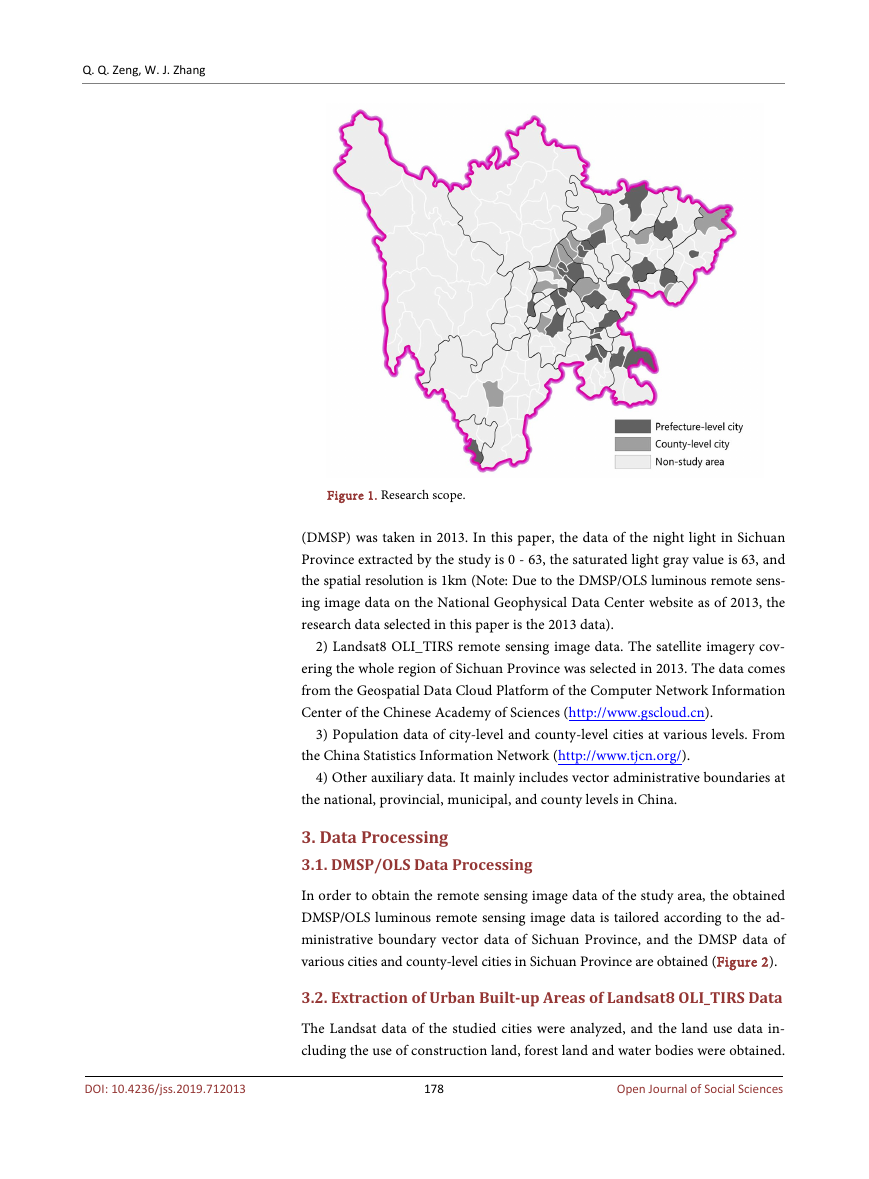
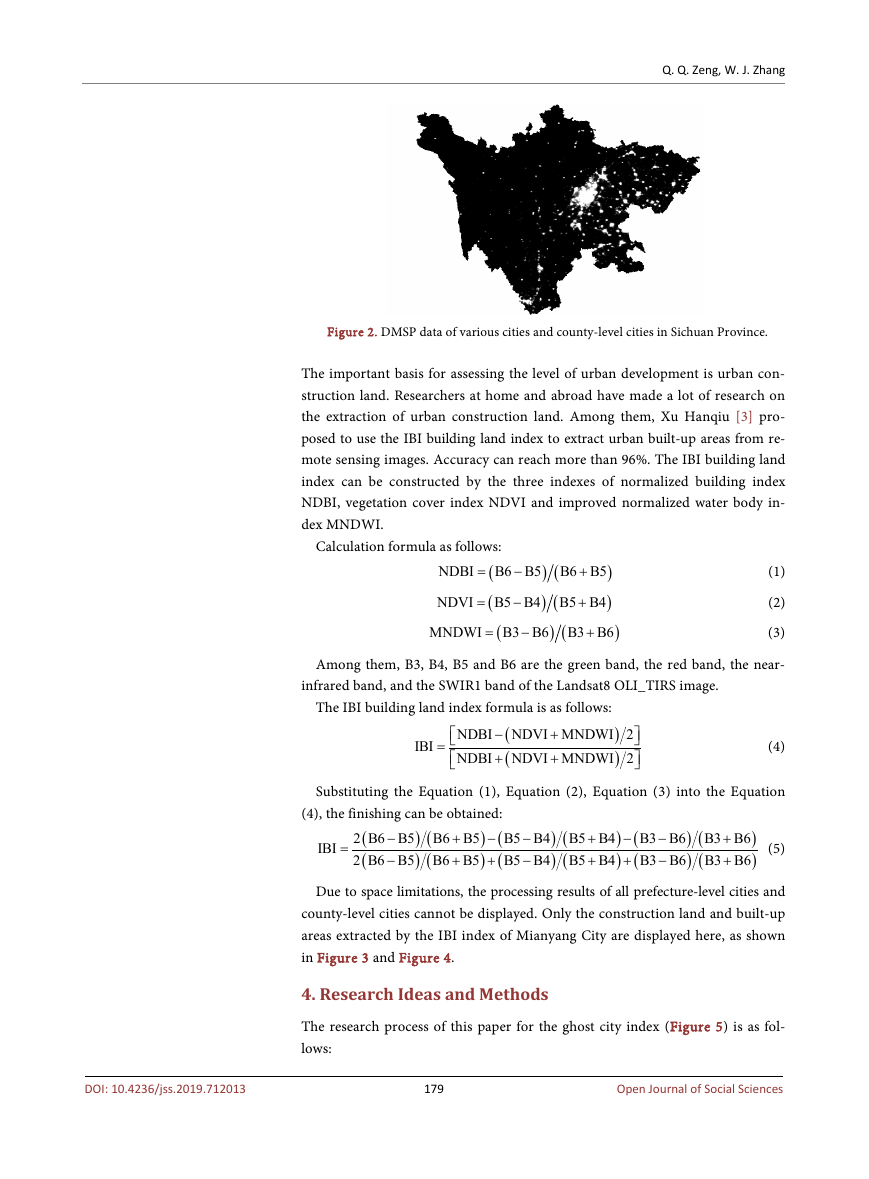
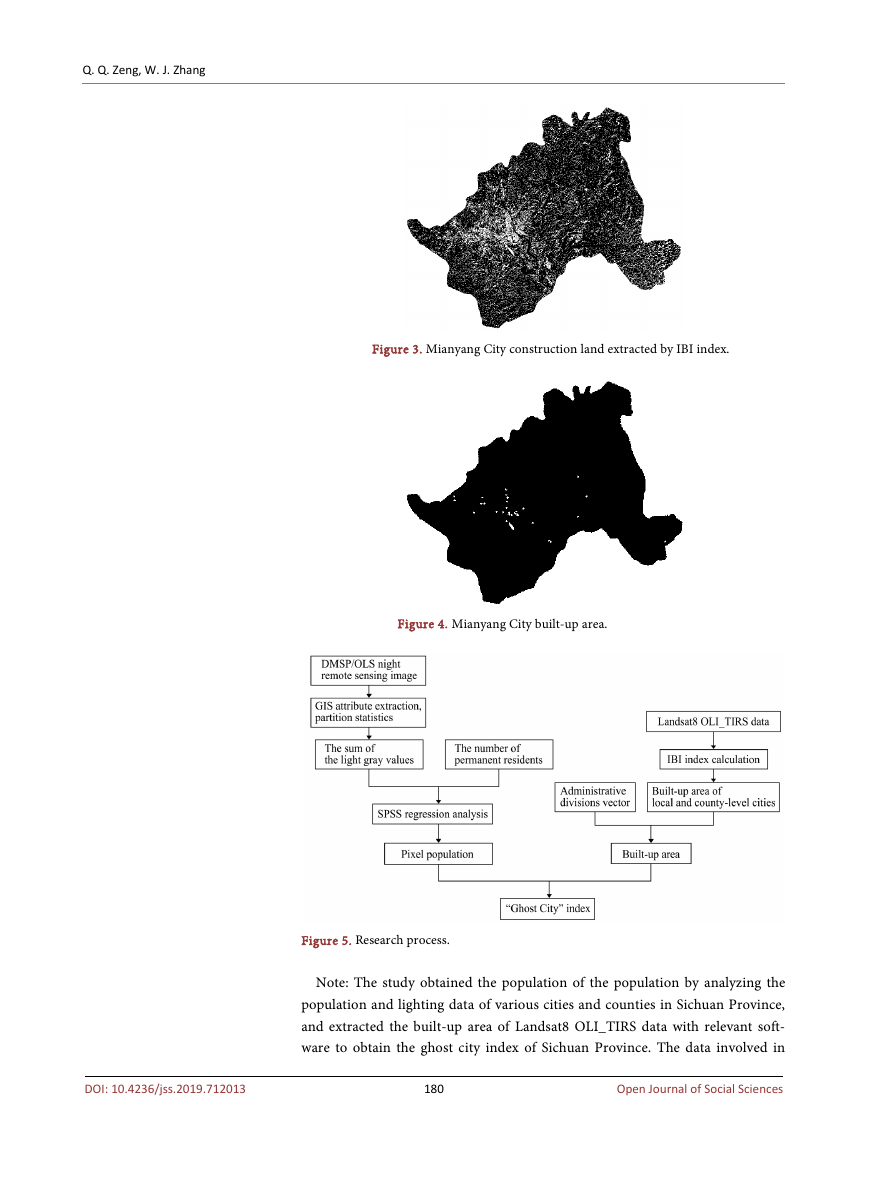
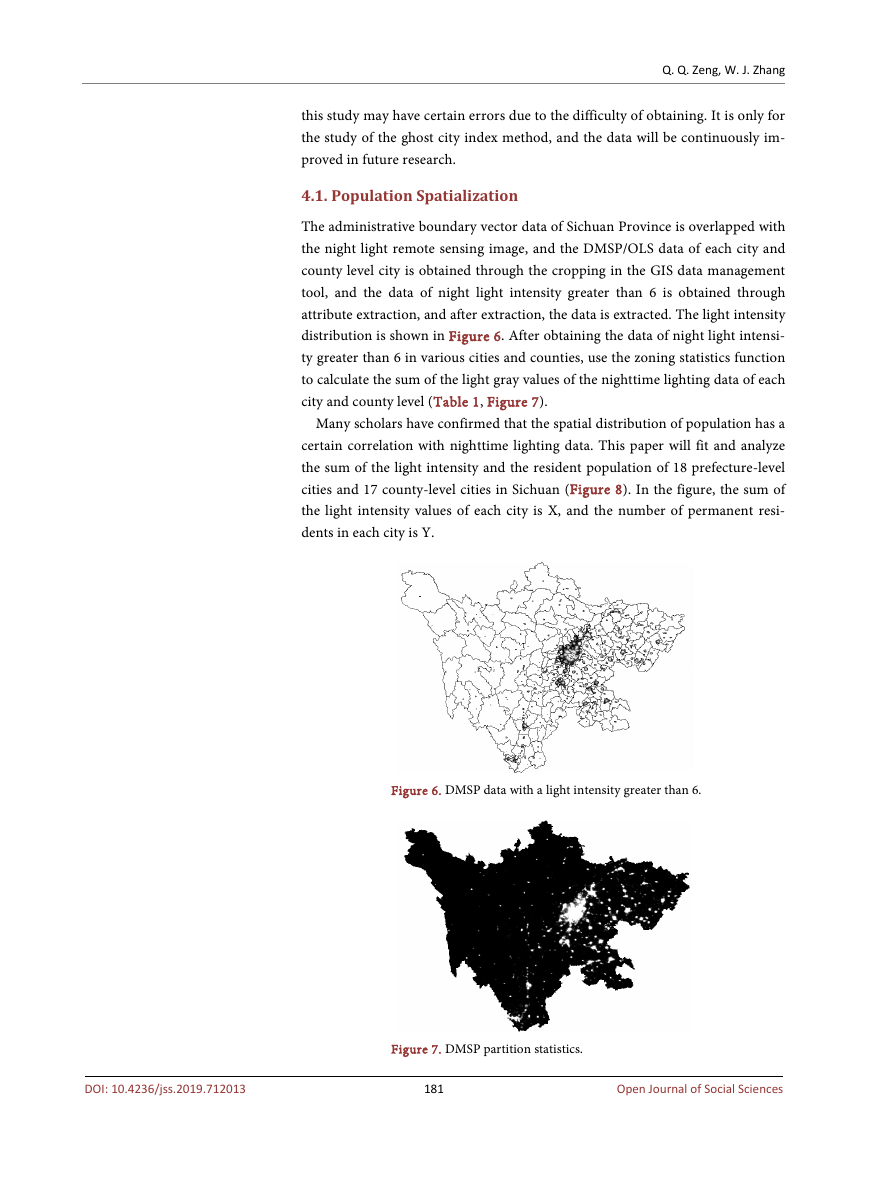
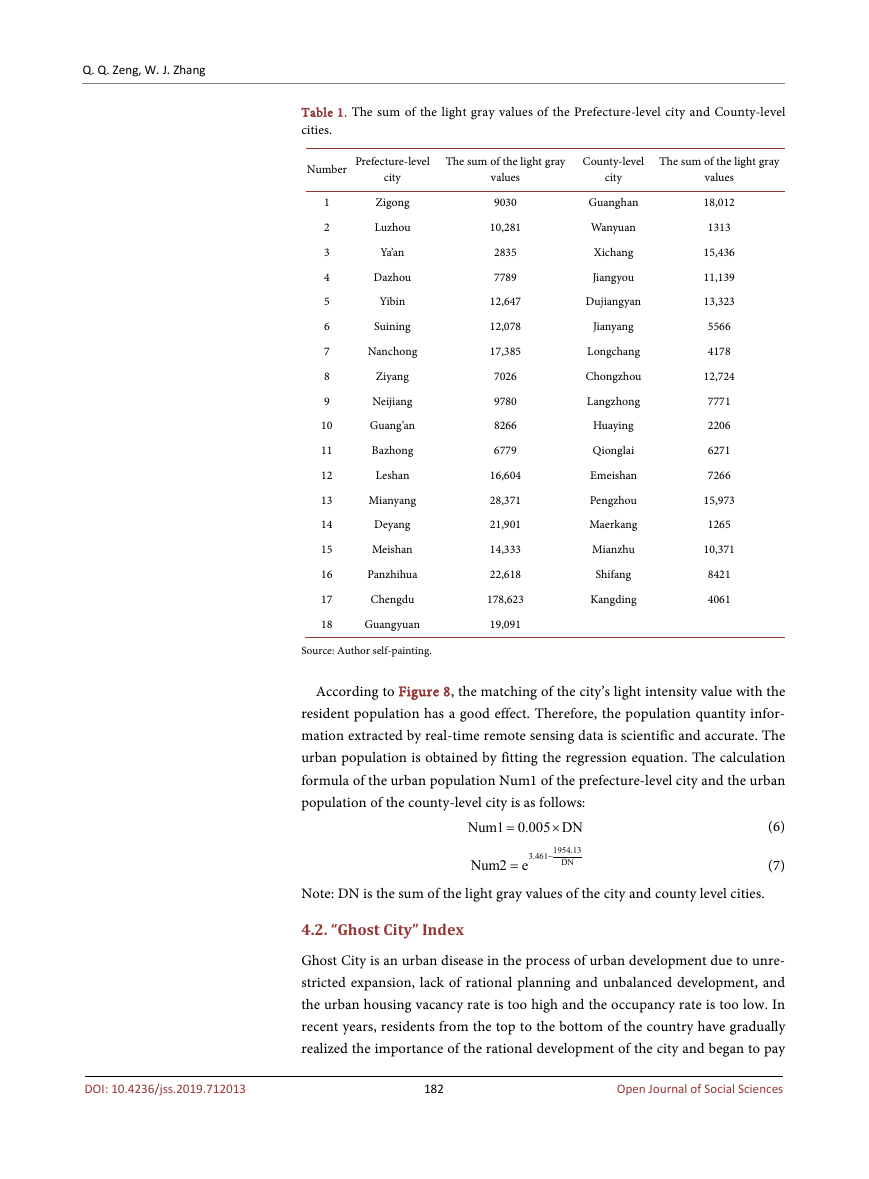
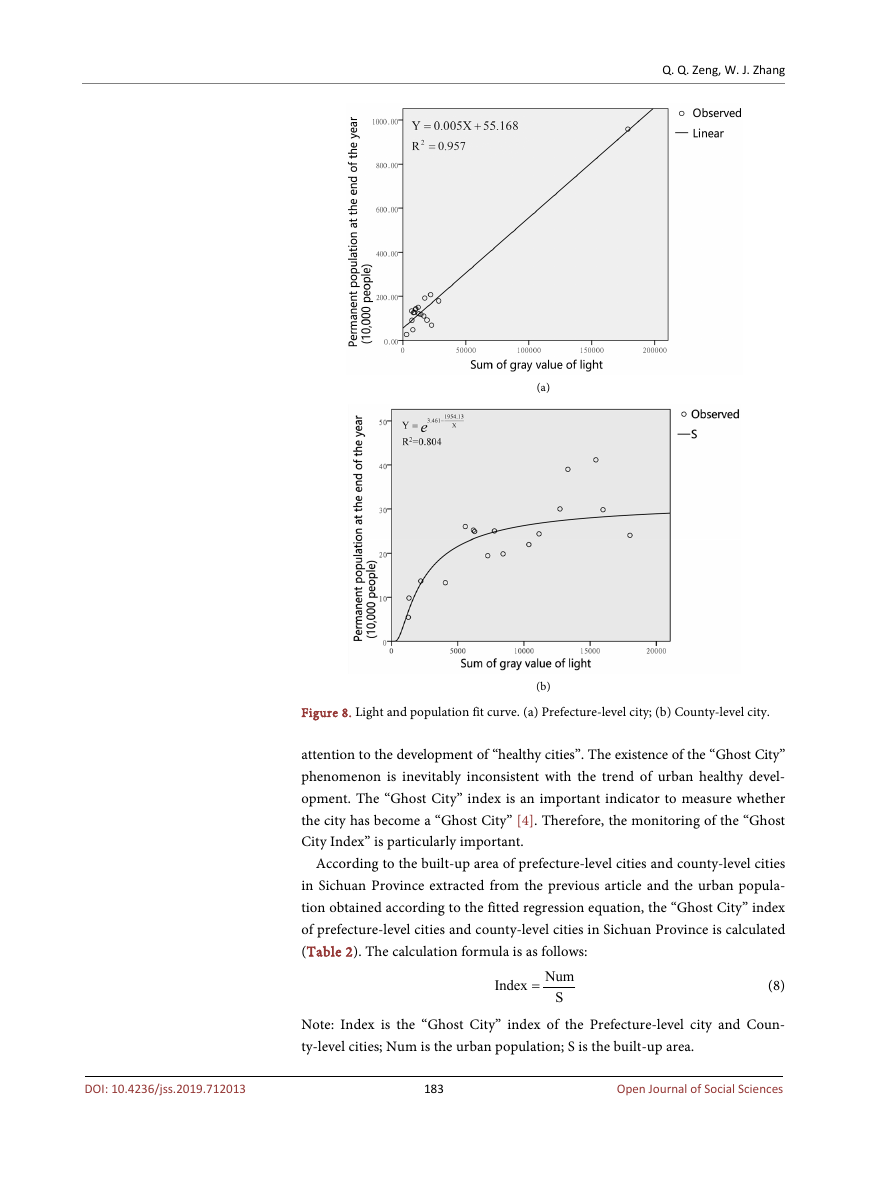








 2023年江西萍乡中考道德与法治真题及答案.doc
2023年江西萍乡中考道德与法治真题及答案.doc 2012年重庆南川中考生物真题及答案.doc
2012年重庆南川中考生物真题及答案.doc 2013年江西师范大学地理学综合及文艺理论基础考研真题.doc
2013年江西师范大学地理学综合及文艺理论基础考研真题.doc 2020年四川甘孜小升初语文真题及答案I卷.doc
2020年四川甘孜小升初语文真题及答案I卷.doc 2020年注册岩土工程师专业基础考试真题及答案.doc
2020年注册岩土工程师专业基础考试真题及答案.doc 2023-2024学年福建省厦门市九年级上学期数学月考试题及答案.doc
2023-2024学年福建省厦门市九年级上学期数学月考试题及答案.doc 2021-2022学年辽宁省沈阳市大东区九年级上学期语文期末试题及答案.doc
2021-2022学年辽宁省沈阳市大东区九年级上学期语文期末试题及答案.doc 2022-2023学年北京东城区初三第一学期物理期末试卷及答案.doc
2022-2023学年北京东城区初三第一学期物理期末试卷及答案.doc 2018上半年江西教师资格初中地理学科知识与教学能力真题及答案.doc
2018上半年江西教师资格初中地理学科知识与教学能力真题及答案.doc 2012年河北国家公务员申论考试真题及答案-省级.doc
2012年河北国家公务员申论考试真题及答案-省级.doc 2020-2021学年江苏省扬州市江都区邵樊片九年级上学期数学第一次质量检测试题及答案.doc
2020-2021学年江苏省扬州市江都区邵樊片九年级上学期数学第一次质量检测试题及答案.doc 2022下半年黑龙江教师资格证中学综合素质真题及答案.doc
2022下半年黑龙江教师资格证中学综合素质真题及答案.doc